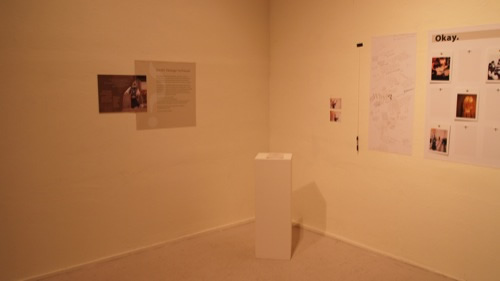Jewish? Heritage? In Poland?
Erica Lehrer & Hannah Smotrich

In post-Holocaust, post-Communist Poland — home now to only a tiny minority of Jews — new representations of Poland’s “Jewish heritage” abound. Especially prevalent in tourist zones, these manifestations are understood, and judged, very differently by local Poles, local Jews and visitors from abroad.
If one single image is a lightening rod for the many questions raised by these new displays of Jewishness, it is the figure of the Jew itself. Caught in a web of overlapping visual histories, the image of the Jew is informed by many precedents: Marc Chagall’s flying rabbis, Roman Vishniac’s impoverished Hasidim, and Hollywood’s Fiddler on the Roof on the one hand and anti-Semitic stereotypes, perfected in Nazi propaganda, on the other.
These representations raise questions:
- of ownership: Can a non-Jew produce Judaica?
- of context: Similar images in Israel or New York arouse no comment.
- of intent: Are these representations memorial, mercenary, talismanic?
On what basis do we deem these images “Okay” or “Not Okay”? You decide. (And tell us why.)
This piece is one sketch in an ongoing investigation of how one might curate ethnography in ways that capture some of the theoretical advances of the post-Writing Culture era: attention to multiple perspectives, assertions of authority, self-reflection, dialogue, global flows, and above all representational experimentation. It grows out of an essay I wrote about the evolving trade in Jewish figurines in Poland (“Repopulating Jewish Poland – in Wood,” Polin 2003). I wanted to see if it was possible to translate into installation form the core argument: that even a hot-button item that many view as “kitsch” (at best) is suspended in a web of international transcultural memorial exchanges in which many of us are implicated. And if this works, perhaps other areas of historical conflict may be curated in ways that create openings for dialogue as well.
The broader experiment is to look at ethnographic data for key social and cultural issues, questions, and problems, and distill these into exhibitable units. Because significant sites, symbols, utterances and gestures communicate on multiple levels and mean different things to different people, a central goal is to find ways make dialogue integral to the exhibit. The aim is to reframe common sights, sounds, and experiences in ways that create new engagement and fresh understanding.
Theoretical inspiration for this approach comes in part from anthropologist Stephen Tyler’s (1986) notion of post-modern ethnography as a “meditative vehicle” whose goal is to “evoke” and open a space for culture to be produced in a “cooperatively evolved text” among variously situated participants. Ethnography, that is, not as a record of experience, but a means of experience.
Collaboration has been fundamental to this work. In order to develop – and to give material form – to my initial ideas, during the past five years I have collaborated with graphic designer Hannah Smotrich on projects including “conversationmaps,” a set of alternative tourist ephemera intended to represent and intervene in the ways visitors experience Jewish heritage in Poland, and “Please Respond” (also with sound artist Stephanie Rowden), a participatory, site-specific installation in a Jewish heritage quarter of Krakow (www.conversationmaps.org/odpowiedz.html). We are continuing to develop elements that can be installed in Jewish museums as well as rooted within the fabric of Poland’s Jewish tourist landscape.
This work is also a product of my larger initiative called Curating Difficult Knowledge, under the auspices of CEREV (Centre for Ethnographic Research and Exhibition in the Aftermath of Violence) at Concordia University in Montreal, Canada. Thanks to Soliman Lawrence for his donation of some of the images used in this project.
Biographies
Erica Lehrer is an assistant professor in the History and Sociology/Anthropology Departments at Concordia University in Montreal, Canada, where she also holds the Canada Research Chair in Post-Conflict Studies. Trained as an anthropologist (Ph.D. Michigan 2005) with an accompanying certificate in museum studies, she is completing a book manuscript tentatively titled Remaking Memory: How Jews and Poles are Salvaging Jewish Heritage in Poland, based on ethnographic fieldwork in Poland, Israel, and the United States. Her research has been supported by fellowships from the Fulbright, IREX, and Mellon foundations, among others. She was recently awarded funds from the Canadian Foundation for Innovation to develop the Center for Ethnographic Research and Exhibition in the aftermath of Violence (CEREV) at Concordia, which includes a digital exhibition lab, “Lab 6 ½.”
Hannah Smotrich is a graphic designer and Associate Professor at the School of Art & Design at the University of Michigan. In her creative practice, Smotrich works collaboratively with a range of non-profit clients on print publications, environmental graphics, and branding. Recent work has centered on communities, identity and cultural history and includes projects such as the design of street markers and accompanying publications for a citywide system of Neighborhood Heritage Trails in Washington, DC, and an exhibit for Museum L-A exploring the lives and communities of former textile workers in Lewiston, Maine. Smotrich holds a BA magna cum laude in History from Harvard College and an MFA in Graphic Design from Yale School of Art.
links: